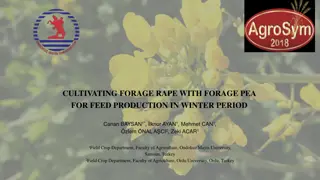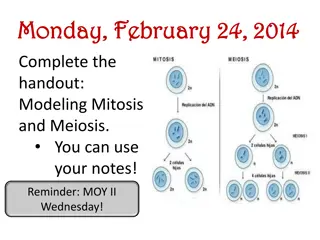Gregor Mendel: The Father of Genetics and His Pea Plant Experiments
Gregor Mendel, an Austrian botanist monk, laid the foundation for the study of heredity with his groundbreaking work on pea plants in the mid-1800s. By observing traits across generations, Mendel formulated the basic laws of genetics, demonstrating how traits are inherited. His experiments with purebred plants and the concept of dominant and recessive traits revolutionized our understanding of genetics.
Download Presentation

Please find below an Image/Link to download the presentation.
The content on the website is provided AS IS for your information and personal use only. It may not be sold, licensed, or shared on other websites without obtaining consent from the author. Download presentation by click this link. If you encounter any issues during the download, it is possible that the publisher has removed the file from their server.
E N D
Presentation Transcript
How We Came to Be 1/20/2015 Entry 2
Question: How do cells make sure that DNA is well protected? How does the message of DNA get out of the cell? Hypothesis: Please write your answers to the questions.
Procedure: In the lab, please follow your teacher s step- by-step instructions. NO EATING OR DRINKING (in the lab OR out of the lab)
Data: Glue In DNA Worksheet.
Conclusion: Gregor Mendel The basic laws of heredity were first formed during the mid- 1800 s by an Austrian botanist monk named Gregor Mendel. Because his work laid the foundation to the study of heredity, Mendel is referred to as The Father of Genetics.
Mendel Pea Plants Mendel based his laws on his studies of garden pea plants. Mendel was able to observe differences in multiple traits over many generations because pea plants reproduce rapidly, and have many visible traits such as: Pod color Seed Color Plant Height Green Yellow Green Yellow Seed Shape Short Pod Shape Tall Wrinkled Round Smooth Pinched
Mendels Experiments Mendel noticed that some plants always produced offspring that had a form of a trait exactly like the parent plant. He called these plants purebred plants. For instance, purebred short plants always produced short offspring and purebred tall plants always produced tall offspring. X Short Offspring Purebred Short Parents X Purebred Tall Parents Tall Offspring
Mendels First Experiment Mendel crossed purebred plants with opposite forms of a trait. He called these plants the parental generation , or P generation. For instance, purebred tall plants were crossed with purebred short plants. X Parent Short P generation Parent Tall P generation Offspring Tall F1 generation Mendel observed that all of the offspring grew to be tall plants. None resembled the short short parent. He called this generation of offspring the first filial , or F1 generation, (The word filial means son in Latin.)
Mendels Second Experiment Mendel then crossed two of the offspring tall plants produced from his first experiment. Parent Plants Offspring X Tall 3 4 Tall & 1 4 Short F2 generation F1 generation Mendel called this second generation of plants the second filial, F2, generation. To his surprise, Mendel observed that this generation had a mix of tall and short plants. This occurred even though none of the F1 parents were short.
Dominant and Recessive Genes Mendel went on to reason that one factor (gene) in a pair may mask, or hide, the other factor. For instance, in his first experiment, when he crossed a purebred tall plant with a purebred short plant, all offspring were tall. Although the F1 offspring all had both tall and short factors, they only displayed the tall factor. He concluded that the tallness factor masked the shortness factor. Today, scientists refer to the factors that control traits as genes. The different forms of a gene are called alleles. Alleles that mask or hide other alleles, such as the tall allele, are said to be dominant. A recessive allele, such as the short allele, is masked, or covered up, whenever the dominant allele is present.
Homozygous Genes What Mendel refered to as a purebred plant we now know this to mean that the plant has two identical genes for a particular trait. For instance, a purebred tall plant has two tall genes and a purebred short plant has two short genes. The modern scientific term for purebred is homozygous. short-short short-short short-short X Short Offspring Short Parents According to Mendel s Law of Segregation, each parent donates one height gene to the offspring. Since each parent had only short genes to donate, all offspring will also have two short genes (homozygous) and will therefore be short.
Hybrid Alleles In Mendel s first experiment, F1 offspring plants received one tall gene and one short gene from the parent plants. Therefore, all offspring contained both alleles, a short allele and a tall allele. When both alleles for a trait are present, the plant is said to be a hybrid for that trait. Today, we call hybrid alleles heterozygous. tall-tall short-tall short-tall short-short X Parent Short P generation Parent Tall P generation Offspring Tall F1 generation Although the offspring have both a tall and a short allele, only the tall allele is expressed and is therefore dominant over short.
Dominant Alleles Mendel observed a variety of dominant alleles in pea plants other than the tall allele. For instance, hybrid plants for seed color always have yellow seeds. Green & Yellow Allele However, a plant that is a hybrid for pod color always displays the green allele. Yellow Seed Green Pod Green & Yellow Allele In addition, round seeds are dominant over wrinkled seeds, and smooth pods are dominant over wrinkled pods.
Law of Dominance Certain alleles are dominant. If those alleles are present then the organism will display those traits. Some alleles are recessive and are hidden by dominant traits. Recessive alleles are only displayed if passed from both parents.
Law of Segregation The two members of a gene pair (alleles) segregate (separate) from each other in the formation of gametes. Half the gametes carry one allele, and the other half carry the other allele. This is why sibling with the same parents may seem very different from each other.
Law of Independent Assortment when two or more characteristics are inherited, individual hereditary factors assort independently during gamete production, giving different traits an equal opportunity of occurring together. According to Mendels Law of Independent Assortment, the gene pairs will separate during the formation of egg or sperm cells. The plant will donate one allele from each pair. The plant will donate either a yellow or green seed allele, either a yellow or green pod allele, and a wrinkled or round seed allele. It will always donate a wrinkled pod shape. The donation of one allele from each pair is independent of any other pair. For example, if the plant donates the yellow seed allele it does not mean that it will also donate the yellow pod allele.
Homework: Disease Project Poster (information: disease, statistics, treatment, life expectancy, 3 pictures) Presentation (Less than 3 minutes; no reading from the poster; the more you practice the better it will be; more points will be given to students that use their notecards very little) Karyotype (printed or drawn)























